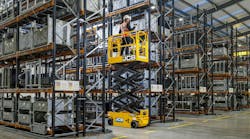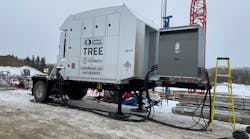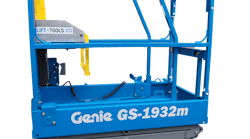How do you determine when concrete pumping is right for your project? What makes this method of concrete placement a more efficient choice than dumping from a ready mix truck, bucketing with a crane or simply using a wheelbarrow?
Pumping concrete helps reap rewards both now and in the future. Contractors report a high level of customer satisfaction and greater opportunities for more projects. Distinct advantages that can positively impact a project's bottom line include time and labor savings, increased profits, improved scheduling, reduced site preparation, employee satisfaction, enhanced quality control, and concrete placing versatility.
The Equipment That Pumps Concrete
A variety of equipment can be used for pumping concrete, including truck-mounted concrete pumps, placing booms, high-pressure/high-output trailer pumps, trailer-mounted concrete pumps, and mortar machines. When equipping a job site with any concrete placing equipment, consider the following:
- Job location
- Job size
- Job complexity
- Safety
- Maximum distance
- Maximum height
- Volume of concrete to place
- Concrete mix design, slump, aggregate, and admixtures
- Site restrictions
- Site congestion
- Reliability
Save Time, Save Money, Increase Profits
A concrete pump places concrete faster and more accurately with less labor than any other method. A job that would take five men two and a half hours to pour would only take three men one hour to pump. Contractors who pump concrete consistently report labor savings of 50 percent compared to truck dumping.
On site, concrete pumping allows reallocation of valuable personnel to other duties. In addition, more ready mix trucks can be discharged in less time using a pump, which means completion of more jobs in a day.
Example: We Energies Oak Creek Power Plant Expansion, Oak Creek, WI
With a full line of Putzmeister boom pumps, Gordy's Concrete Pumping Service (Gordy's) was able to create a great platform for their company, run more efficiently for their customers and cut down labor costs for their customers as well. This was particularly important when placing the largest amount of concrete consumed on a site in the Midwest as of January 2007.
Site Specs:
- 130,000 cubic yards of concrete pumped and placed by boom pumps
- 11 different concrete mixes available per specification
- Maneuverability and quick setup of the boom pumps allowed Gordy's to keep the project moving as efficiently as possible
- The 63Z-Meter boom pump used on site is extensive — 203 feet 9 inches vertically and 190 feet 7 inches horizontally
Scheduling is one of the most critical aspects of a concrete pour. There is no room for down time on a busy job site. Contractors with the right equipment place concrete efficiently, regardless of weather, time of day or jobsite conditions. Positioning of equipment and maneuvering around a site can also be critical factors in determining the best concrete placing method.
Example: Hollywood & Vine — W Hotel & Residences, Hollywood, CA
"An entire year of planning and coordination was conducted between Webcor and JLS for this project," says Vern Lee, construction manager for Webcor. "It was a must to have everything planned to a 'T' because of Hollywood & Vine's massive footprint and opening date in the fall of 2009."
"Every detail was scrutinized in planning the three pumping stations and the impressive 3,640 feet (1,110 meters) of below-grade delivery line system," comments Willie Clemison of JLS. "The placing system includes both horizontal and vertical piping. Webcor and JLS had to ensure the delivery system could transport concrete to any of the six placing booms with no problem and also allow three placing booms to place concrete at the same time."
They used Putzmeister BSA 14000 to reliably pump the long distances this project required.
Site Specs:
- Curb-to-curb 4.6-acre footprint
- Pumping and placing three different concrete mixes at any given time with six placing booms
- 4,000- to 8,000-psi concrete mixes
- 108,000 cubic yards of concrete
- Placing booms on site have a horizontal reach of 115 feet 3 inches and vertical reach of 122 feet 8 inches
- Six placing booms, pin towers and pumps
Concrete pumps help mixer dispatchers by providing more predictable unloading times. The steady flow from the pump can also increase finisher productivity due to the lack of interruptions and delays.
Unlike human resources, pumps show up for work on time without complaint and never take a lunch break. In the event of a problem, backup systems can keep a pump running through job completion, and wear parts are designed for easy replacement.
Site preparation for a typical pour can be time-consuming, labor intensive and unpredictable, hampering efficient scheduling.
Eliminating the need to build and move access ramps, concrete pumping can very often facilitate completion of an entire job from one location while keeping ready mix trucks safely at the curb. Pumps also reduce excavating time from 10 percent to 15 percent and make backfilling easier.
Employee Productivity And Safety
Concrete pumping not only makes a concrete pour more convenient and consistent, it improves on-the-job safety. Ready mix trucks are kept at the curb, away from embankments, excavations and other dangerous obstructions so concrete can be placed exactly where it's needed.
In addition, a concrete pump reduces congestion on the job site better than most other methods, improving job efficiency and safety. Fewer risks and a more ergonomic process are benefits to on-site employees that can result in less sick days and a smoother-running business.
Labor and time savings mean nothing if the quality of concrete placement does not meet expectations. For years, contractors pumping concrete have produced superior quality while reducing costly callbacks. Direct placement of concrete without re-handling also improves concrete quality.
In addition, concrete pumping does not require special mixes for optimum quality. A concrete pump will handle desired slumps and eliminate the need for excess water that can result in concrete cracking.
The tallest buildings built in the past decade were pumped, even in excess of 1,900 feet high. Pumps can also achieve capacities in excess of 150 cubic yards per hour. Whether at ground level or on an impressive skyscraper, pumping concrete is the versatile and convenient way to get the job done right.
Boom pumps can navigate up and over obstacles as well as into confined spaces to deliver results not possible with other methods.
In addition, choosing to pump concrete can also be a function of the distance that the material must be conveyed. Tunneling and mining are two good examples of when the advantages of pumping cannot be ignored.
Example: West Area Combined Sewer Overflows (CSOs) Tunnels and Pumping Station, Atlanta, GA
"For the North Avenue Tunnel concrete linings, the BSA 14000 is pumping 2,800 feet via slick line," comments Darrell Liebno, assistant project manager for Atlanta CSO Constructors (ACC). "Its high line of pressure of 3,190 psi and high output volumes of 133 cubic yards per hour have benefited us greatly, given the long distances the project requires the concrete to be placed."
"The electrically driven BSA 2109H is rail-mounted, which allows for high mobility in the Clear Creek Tunnel," adds Adam Stremcha, project engineer for ACC. "Using electric power, this machine is also environmentally friendly in its underground surroundings by giving off zero emissions."
Site Specs:
- Atlanta's largest tunneling project
- Two tunnels will have a combined length of 43,800 feet and are anywhere from 160 to 320 feet below ground level
- Concrete is delivered above and below ground by trailer pump and tunneling concrete placing equipment
- 120,000 cubic yards of concrete pumped
- 4,000-psi concrete mix
From small trailer-mounted pumps to the most powerful line pumps and longest truck-mounted boom pumps, concrete contractors have a wide variety of choices for countless applications, including:
- Mat pours
- Footings
- Indoor pours
- Slope paving
- High-rise buildings
- Mid-rise buildings
- Residential pours
- Light commercial
- Industrial
- Bridge decks
- Post tension slabs
- Tunneling
- Pools/shotcreting
- Patios
Concrete pump manufacturers like Putzmeister America work with customers to determine the most appropriate method of placement based on the entire scope of a project. From residential foundations to the world's tallest buildings, concrete pumping offers efficiency, quality and bottom line benefits.
| Author Information |
| Kelly Hayes is the marketing manager for Putzmeister America, Inc. |




